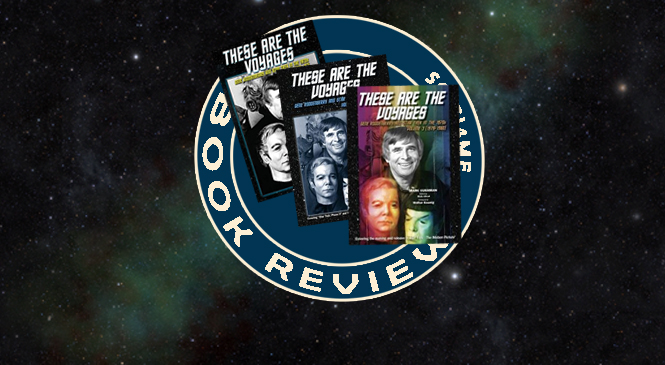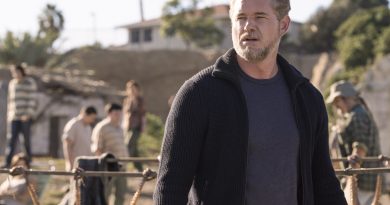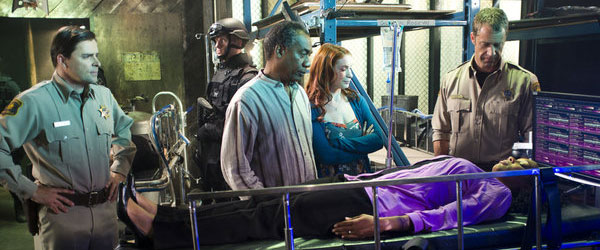THESE ARE THE VOYAGES: A Trip Worth Taking

To say that Gene Roddenberry’s career was complicated would be underselling it a bit.
In what could very well be one of the most comprehensive documentary works about Roddenberry, Marc Cushman’s These Are The Voyages series takes the reader on a deep dive behind the scenes into what could only be a television story: the rise of Star Trek as a cultural phenomenon at the same time its creator was diminished and pushed aside.
These are the second set of tomes, each concentrating on the time in Roddenberry’s career between the end of Star Trek‘s original run on television all the way up through the production of the first motion picture. Along the way, we meet Questor, the many faces of Dylan Hunt, and more.
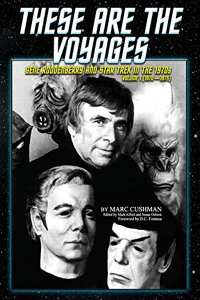
These Are The Voyages: Gene Roddenberry and Star Trek in the 1970s, Volume 1
Written by Marc Cushman
Published by Jacobs Brown Press
Hardback, 763 pages
In this first volume, we get a look at the immediate aftermath following the cancellation of Star Trek, the toll it took on Roddenberry and the cast. Through an impressive amount of research and documentation, Cushman has assembled the chronology starting with the beginning of reruns. Through the course of a couple of years, the series became a sleeper hit, gaining more fans and sparking interest in a revival. As Roddenberry was realizing what kind of sleeping giant had been awakened, he was also dealing with the fact that while Star Trek was gaining in popularity and spawning merchandise and convention frenzy, Paramount was reluctant to revive the show because they felt it would damage the profits from the syndication of the original seventy-nine episodes.
While the studio was dithering on whether or not to produce more Star Trek after having killed it in the first place, Roddenberry continued to work on other projects, trying to escape the “science fiction writer” label he now carried. What followed was a series of productions that never quite got off the ground, or weren’t well received. Roddenberry seemed to be the one-hit wonder. Pretty Maids All in a Row was a clear departure for him. Genesis II had potential, but was spoiled by the network — and Roddenberry’s continued battles with studio and network executives. Ultimately, it was always his downfall. And from the documents and interviews compiled by Cushman, it’s clear that neither Paramount nor NBC ever really understood what to do with Star Trek or any other of Roddenberry’s series ideas.
It’s interesting to note that Roddenberry attempted to produce a new version of Tarzan, with the usual creative clashes with powers-that-be. In the midst of this, Filmation managed to convince him to go in for an animated version of Star Trek. This volume goes into quite a bit of detail on the development of the series with D.C. Fontana back on board as story editor and many writers from the original series crafting new stories — and from the outset, the Filmation crew made every effort to make this the fourth season of the original show, with the return of the original cast, absent Walter Koenig. Along the way, Roddenberry created The Questor Tapes, which was also the victim of network meddling — so much so that the series concept hardly matched the pilot.
The positive press and audience response to the animated show, combined with the expanding fanzines and conventions, paved the way for Star Trek‘s return later, but it was still a long road to get there.
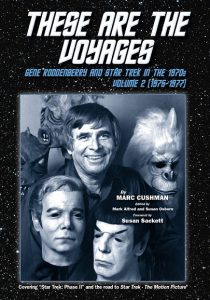
These Are The Voyages: Gene Roddenberry and Star Trek in the 1970s, Volume 2
Written by Marc Cushman
Published by Jacobs Brown Press
Hardback, 668 pages
The second volume of the set covers the years 1975-1977, with details on the back and forth between Roddenberry, Paramount, NBC, and a lot of people who (again) didn’t quite understand what they had on their hands.
Following the growth in popularity of Star Trek in syndication, boosted by the relative success of the animated series, Paramount had finally decided that it was time to develop new Trek. Only they couldn’t make up their minds if they wanted a new series with the original crew, a new series with a new crew, a series of TV movies that might spin off into a new series, or a feature film.
As Roddenberry was writing (and fighting) on Star Trek, the studio was constantly changing direction. Eventually, they settled on a TV movie, but then that became the now-famous Phase II, which didn’t happen because after having spent a great deal of money to build sets for the new show, they did a one-eighty and decided (thanks, in part, to Star Wars) to make a feature film after all. The first half of the book deals with the many changes of direction with regard to format and the seemingly endless search for the perfect script with which to re-launch Star Trek. Everyone had different ideas as to what would work.
In the meantime, we catch up with the cast and their battles (only some successful) with typecasting. Only Shatner and Nimoy were really able to pull away from Kirk and Spock to keep their careers going. And Roddenberry was working on other ideas at the time as well, developing Spectre and Battleground: Earth, what eventually ended up on the screen as Earth: Final Conflict after Roddenberry’s passing.
Then back to Phase II and the development of scripts, set construction, and casting. Seeing Persis Khambatta is bittersweet because of the tragedy of her death, but it’s fun to see her in a uniform from the original series.
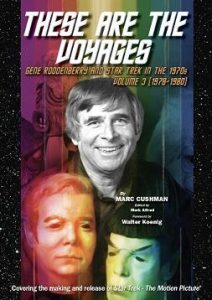
These Are The Voyages: Gene Roddenberry and Star Trek in the 1970s, Volume 3
Written by Marc Cushman
Published by Jacobs Brown Press
Hardback, 474 pages
Once Paramount finally decided to make Star Trek: The Motion Picture, you would think that would be the end of the beginning, and everyone goes sailing off into the sunset of a successful film franchise.
Well, in a word… no.
The script was constantly changing, so much so that pages were time-stamped to the minute when they were changed so everyone knew which was the latest revision. It wasn’t helped at all by the fact that Roddenberry and Harold Livingston were in a battle for control of the script. The cast made the best of it, and director Robert Wise was said to be the professional gentleman on set. But the movie was already over budget before cameras ever started rolling, because the Phase II work was included in the ledger.
Add to that a visual effects shop that spent a ton of money and had nothing to show for it, thus creating a post-production bottle-neck, plus meddling from the studio, plus Roddenberry getting sidelined on his own production… the hits just came one after the other. Honestly, it’s a wonder this film was delivered to the theaters at all. And it wasn’t finished, either. No final sound mix, some of the visual effects were incomplete, and the title sequence was made up of placeholder cards. It wasn’t until the Director’s Edition was released in 2001 that we got to see what it should have looked like in 1979.
Overall, it’s an impressive body of work. Cushman and his team have clearly done their homework, scouring hundreds (perhaps thousands) of documents, letters, memos, newspaper clippings, as well as going through old interviews as well as conducting new ones for these books.
The insights into the production of the various shows, from the animated series to the various projects that never quite got off the ground, offers us a glimpse of the battles that Roddenberry had with the studios at every turn. And it’s clear that some of the problems he faced were of his own making. Roddenberry is not presented as the perfect Great Bird of the Galaxy by any stretch of the imagination, and that actually lends more credibility to this historical narrative. While Roddenberry tried to put a good face on the circumstances, there are times when it’s clear that Star Trek was both albatross and golden goose. (Well, it made money for somebody…)
Even though you sort of know how it ends, the journey to get there makes for — dare I say it? — fascinating reading. I lost count of how many times I found myself shaking my head at the machinations and office politics at play. And after reading these books, I’m convinced more than ever that no matter who’s in charge of Star Trek at Paramount, they’ve never understood it. While Roddenberry’s vision was essentially unsustainable and had to grow into something more than its creator, it was the creative teams who made these productions go as far as they did.
The sad part of it all is the toll it took on Roddenberry, both physically and emotionally. Star Trek was the girlfriend, then ex-girlfriend, who still worked in the office. It served to typecast not only the actors, but the creator. And as the studios pushed Roddenberry out to the point where his involvement was pretty much in name only, one wonders what Star Trek would have been like had he been able to maintain control of the property longer. Would it have been as good? Would it have survived this long?
This set of books is a must have for any die-hard Star Trek fan. Even for the casual fans, it’s a glimpse into a world that doesn’t much exist anymore. The historical aspects alone make it well worth the time.
![]()

